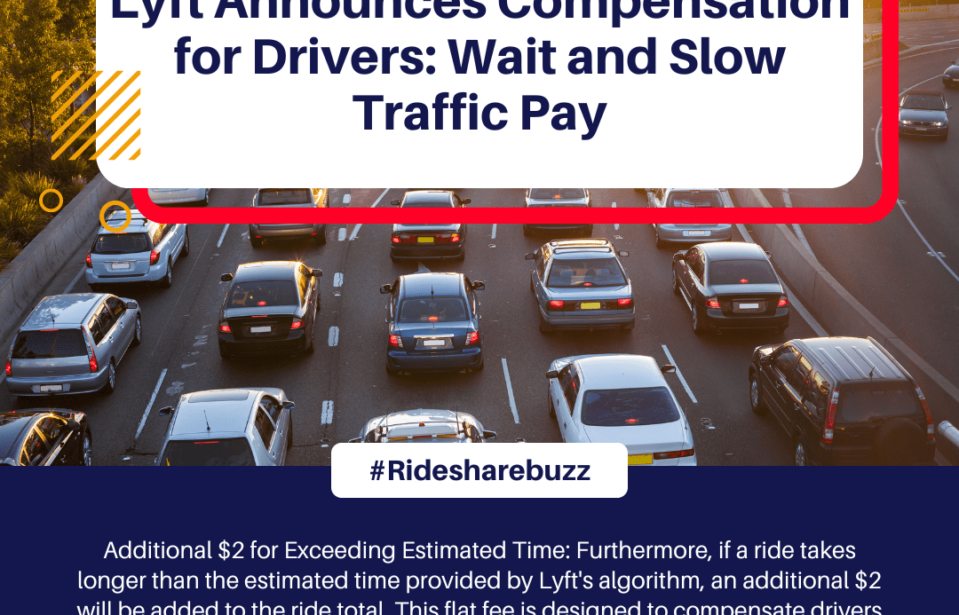Lyft, a leading ride-sharing company in the United States, has recently introduced a driver-centric initiative called Wait and Slow Traffic Pay. This policy, set to roll out in phases starting January 2023, aims to address a common concern among drivers – unexpected delays during their trips. With this move, Lyft is taking a significant step forward in recognizing and valuing the time and dedication of its valued driver community.
Details of Wait and Slow Traffic Pay:
Lyft’s Wait and Slow Traffic Pay is specifically designed to provide additional compensation to drivers who experience unforeseen delays while on the road. These delays can include scenarios such as waiting for passengers beyond the expected timeframe or navigating through heavy traffic congestion. Here’s an in-depth look at how the policy will work:
Eligibility:
- Unexpected Wait Times: Lyft drivers will be eligible for compensation if they have to wait for passengers longer than a predetermined threshold. This typically applies when passengers request a ride but keep the driver waiting beyond a reasonable arrival time.
- Slow Traffic Conditions: Compensation will also be provided when drivers encounter unexpectedly slow-moving traffic during their trips, resulting in longer travel times to complete the ride.
- Minimum Distance or Time Threshold: To qualify for Wait and Slow Traffic Pay, a trip may need to exceed a certain minimum distance or time threshold. For example, a ride may need to be longer than a few miles or last for a certain number of minutes to be eligible for compensation.
Compensation Amounts:
- Flat Fee for Wait Times: Lyft will introduce a flat fee structure for wait times, regardless of the actual duration of the delay. This flat fee will vary depending on the city or market and will be clearly communicated to drivers in advance.
- Additional Pay for Slow Traffic: In cases of slow traffic, drivers will receive extra pay based on the additional time and distance driven due to the delay. The compensation rate may be calculated using a multiplier of their average earnings per mile or minute.
- Minimum Earnings Guarantee: Lyft may also implement a minimum earnings guarantee for eligible trips. This ensures that drivers receive reasonable compensation even during shorter or less profitable rides with unexpected delays.
- Additional $2 for Exceeding Estimated Time: Furthermore, if a ride takes longer than the estimated time provided by Lyft’s algorithm, an additional $2 will be added to the ride total. This flat fee is designed to compensate drivers for the extended duration of the trip.
Claims Process:
- In-App Reporting: Drivers will have the convenience of reporting eligible delays directly through the Lyft app. They can either provide feedback on a completed trip or use a dedicated feature specifically designed for this purpose.
- GPS Data Verification: Lyft will leverage GPS data to verify the occurrence and extent of the delay. This includes tracking the driver’s location, speed, and real-time traffic conditions during the trip.
- Machine Learning Algorithms: Advanced machine learning algorithms will analyze and validate the reported delays, ensuring accuracy and preventing any potential abuse or fraud.
Benefits for Drivers:
- Additional Income: Wait and Slow Traffic Pay translates to extra income for drivers, helping them offset various expenses associated with their work, such as fuel costs, vehicle maintenance, and wear and tear.
- Fair Compensation: The policy ensures that drivers are fairly compensated for delays that are beyond their control, recognizing the value of their time and contributions to the ride-sharing platform.
- Improved Job Satisfaction: By addressing a common pain point, Lyft is likely to enhance driver satisfaction and loyalty, leading to better driver retention and an overall positive driving experience.
Impact on Passengers:
- No Surge in Prices: Lyft has assured passengers that the Wait and Slow Traffic Pay program will not result in higher prices for rides. Passengers will continue to pay the standard rates determined by distance, time, and demand.
- Waiting Time Fees: Passengers may still incur waiting time fees if they request a ride and keep the driver waiting, consistent with Lyft’s existing policies.
- Excluded Scenarios: Delays that are expected, such as scheduled airport pickups or rides during peak hours with anticipated traffic, will not fall under this new compensation policy.
Industry Context and Implications:
- Improving Driver Relations: Lyft’s announcement comes at a time when ride-sharing companies are under scrutiny for their treatment of drivers. By introducing Wait and Slow Traffic Pay, Lyft demonstrates its commitment to improving driver relations and working conditions.
- Rival Companies’ Initiatives: Lyft’s rival, Uber, has also been testing similar compensation policies for wait times and slow traffic. This indicates a positive industry-wide shift toward prioritizing driver satisfaction and experience.
- Independent Contractor Status: The classification of drivers as independent contractors has been a subject of debate. By providing additional benefits and protections, ride-sharing companies can enhance the overall attractiveness of the gig economy and improve their relationship with their driver communities.
Conclusion:
Lyft’s Wait and Slow Traffic Pay policy is a welcome change that showcases the company’s dedication to supporting its drivers. As the policy rolls out across the nation, maintaining transparency and fairness in eligibility criteria, compensation amounts, and the claims process will be crucial. By valuing drivers’ time and contributions, Lyft is fostering a positive and mutually beneficial relationship with its driver community, ultimately enhancing the ride-sharing experience for all stakeholders.





Watch videos from the guy’s viewpoint to feel just like you’re
right in the center of the action and obtain a
good view! You could find big booties in just about any other category you can think of!
Whether you’re into curvy teens, attractive MILFs,
or thick Asians, they all have a spot here. Browse the bouncing,
backshots, and amazing action in group sex, gangbangs, anal,
one-on-one, plus much more. https://ebony-webzobp925703.blogstival.com/51073766/get-more-and-higher-intercourse-with-how-to-sell-nudes
Thhis is a topic that’s close to my heart… Take care!
Where arre your contact details though? https://TRI1Ls.Webflow.io/